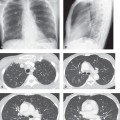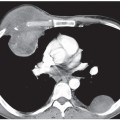CASE 115 51-year-old female non-smoker with progressive dyspnea over the last several months PA (Fig. 115.1A) and lateral (Fig. 115.1B) chest radiographs reveal bilateral perihilar ground glass opacities and ill-defined subcentimeter nodular opacities. Note the preservation of lung volume and the absence of pulmonary edema, pleural effusions, and lymphadenopathy. Chest CT (Figs. 115.1C, 115.1D, 115.1E, 115.1F, 115.1G, 115.1H) (lung window) demonstrates mosaic perfusion and diffuse, patchy, ground glass opacities with innumerable ill-defined, “fuzzy” centrilobular nodules. Note the lobular areas of hypoattenuated lung parenchyma (Figs. 115.1D, 115.1E, 115.1H) Subacute Hypersensitivity Pneumonitis (Bird Fancier’s Lung) • Respiratory Bronchiolitis (RB) (cigarette smokers) • Respiratory Bronchiolitis–Interstitial Lung Disease (RB-ILD) (cigarette smokers) • Desquamative Interstitial Pneumonia (DIP) (cigarette smokers) • Pneumocystis jiroveci Pneumonia (immunocompromised patients) Hypersensitivity pneumonitis (HP), also known as extrinsic allergic alveolitis (EAA), is an immunologic reaction to inhaled organic antigens (e.g., animal proteins, bacteria, fungi, and various chemicals) that produces a diffuse interstitial granulomatous lung disease that varies in its intensity, clinical presentation, and natural history. There are a variety of known antigens as indicated above. Most exposures are occupational or recreational in nature. Farmer’s lung and bird fancier’s lung are the most common forms of HP. Farmer’s lung results from exposure to a bacterium in moldy hay and most often demonstrates upper lung zone predominance. Bird fancier’s lung results from chronic exposure to proteins from bird feathers, serum, or excrement, and most often demonstrates mid–lung zone predominance. This particular patient had six exotic birds at home that were imported from overseas. Her symptoms gradually developed over the first two months after having brought the birds into her home. HP has been classified into acute, subacute, and chronic forms although patients tend to present clinically with subacute or chronic disease. Patients with acute HP present with a sudden onset of flu-like symptoms (e.g., fevers, chills, malaise, cough, and shortness of breath) within a few hours of heavy exposure to the antigen. Subacute HP is somewhat more insidious. Affected patients become symptomatic with cough and dyspnea over a period of days or weeks following intermittent and continuous exposure to low-dose antigens. Chronic HP
 Clinical Presentation
Clinical Presentation
 Radiologic Findings
Radiologic Findings
 Diagnosis
Diagnosis
 Differential Diagnosis
Differential Diagnosis
 Discussion
Discussion
Background
Etiology
Clinical Findings
![]()
Stay updated, free articles. Join our Telegram channel

Full access? Get Clinical Tree





